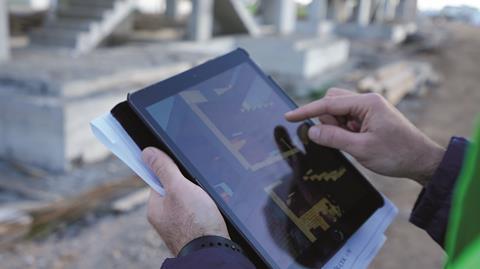What are the main obstacles to implementing the golden thread of information central to the ║┌Â┤╔šă° Safety BillÔÇÖs new regulatory system ÔÇô and how can firms overcome them? ║┌Â┤╔šă°, along with construction software firm Trimble Viewpoint, surveyed the industry to find out

The biggest changes to building safety in a generation are under way ÔÇô with firms working in the built environment set to be operating in a completely new regulatory environment. The ║┌Â┤╔šă° Safety Bill, which is currently part-way through the process of becoming legislation, is set to forever change the way construction firms operate and ensure the safety of the UKÔÇÖs built assets moving forward. And the golden thread, a digital record of all key building information (see box for the full description), is a central part of these reforms.
Implementing the golden thread means firms will need to keep a detailed audit trail of each stage of the construction and design process and meet the required standards. But are firms and the industry as a whole ready? Working with construction software firm Trimble Viewpoint, ║┌Â┤╔šă° has carried out a survey*, ║┌Â┤╔šă° Safety: Managing the Golden Thread, to ascertain how prepared the industry is to implement the upcoming regulatory change, identify the barriers and, most importantly, establish what needs to be addressed to overcome them.
Key obstacles

A cultural barrier within the construction sector, an industry long maligned for its disjointed and siloed approach, was adjudged to be the most significant barrier to maintaining an accurate audit trail on projects when firms were asked to look at the industry as a whole ÔÇô with almost 80% of respondents saying it was a hurdle that needed to be overcome. Ben Wallbank, BIM strategy and partnerships manager at Trimble Viewpoint, says: ÔÇťWe often talk about teams on construction projects working in silos and the benefits of breaking these down.ÔÇŁ
However, asking respondents what the biggest challenge was for their own firms produced a different answer. Culture was still deemed to be a significant barrier, with 46% of people raising it as an issue. But supply chain collaboration and identification of the dutyholder as defined by the golden thread ÔÇô that is, the person responsible for ensuring the audit trailÔÇÖs veracity ÔÇô were deemed just as significant, at 49% and 45% respectively.
And this is where implementing the proper procedures, supported by the proper tools, becomes key. On this point Steve Underwood, chief operating officer at Birmingham-based contractor Colmore Tang, says it is imperative that firms do not work in isolation and are aware of what everyone else on the project is doing. ÔÇťWe run an open system that allows subcontractors to see exactly where other subcontractors are,ÔÇŁ he says. ÔÇťWhat that does is promote a spirit of collaboration between the subcontractors.ÔÇŁ
Standardised approach

Wallbank adds that a move to a more standardised approach could pave the way. ÔÇťThe more standardisation that we can get both nationally and internationally, everything that we can do that will make the way you do things more regular from project to project, from team to team, the better.ÔÇŁ
In fact, if properly implemented the industry seems confident the collaborative culture shift that should ensue would not only improve building safety but come with a host of other benefits. Almost 90% of respondents to the survey said they feel an accurate digital audit trail will facilitate better decision-making and improve accountability across the built environment, while the capture of information in real time and improved quality of work through project management and workflow are also considered to be significant potential benefits by 55% and 75% of respondents respectively.

But to realise these benefits it is key that the golden thread ideology is implemented and managed properly. To this end, Wallbank says: ÔÇťThe more transparent, real-time and collaborative a project can be, the more beneficial the golden thread can be for everyone.ÔÇŁ
With all these factors in mind, it is clear that firms need to look at the challenges they will face in implementing the digital audit trails needed for the golden thread and what they can do to tackle them in order to reap the benefits that could be achieved.
What is the golden thread?
- The golden thread will hold the information those responsible for the building require to:
- Show the buildingÔÇÖs compliance with building regulations during construction and provide evidence of meeting the requirements of the new building control route through the design, construction, and refurbishment of a building
- Identify, understand, manage, and mitigate building safety risks to prevent or reduce the severity of the consequences of fire spread or structural collapse
- The information stored in the golden thread will be reviewed and managed so the information retained achieves these purposes.
- The golden thread covers both the information and documents, and the information management processes used to support building safety.
- The golden thread information should be stored as structured digital information. It will be stored, managed, maintained and retained in line with the golden thread principles.
- The golden thread information management approach will apply through design, construction, occupation, refurbishment and ongoing management of buildings.
- ║┌Â┤╔šă° safety should be taken to include the fire and structural safety of a building and the safety of all the people in or in the vicinity of a building, including emergency responders.
- Many people will need to access the golden thread to update and share golden thread information throughout a buildingÔÇÖs lifecycle, including but not limited to building managers, architects and contractors.
Source: ║┌Â┤╔šă° Regulations Advisory Committee: Golden Thread Report
*The survey ran from 11 February to 3 March

























